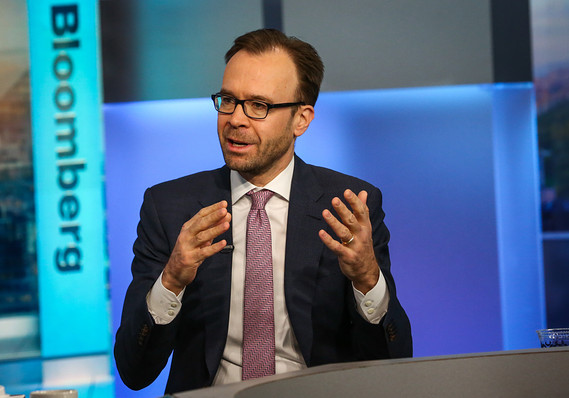 Bloomberg
Bloomberg
Ahead of the Federal Reserve’s monetary-policy meeting on Tuesday and Wednesday, MarketWatch talked with Jan Hatzius, chief economist at Goldman Sachs, about the outlook for the U.S. central bank.
As financial markets — and President Donald Trump — have cried out for rate cuts, Hatzius has remained skeptical all year about the need for lower rates and still doesn’t think a July cut is necessary. But one is coming anyway, he said, followed, probably, by another in September. And that’s it. Then the bond market might have to reprice.
The Goldman GS, -0.48% economist thinks the bond market’s flat yield curve is confusing investors and the Fed. A flat yield curve is seen by many as a reliable sign of a recession. Hatzius said Goldman’s financial-conditions index actually shows the opposite — that financial conditions are actually more easy than at any time since last summer.
MarketWatch: Going into the Fed meeting, what are you expecting?
Hatzius: A 25-basis-point cut. And I think our current forecast is they cut 25 [basis points] in July and 25 in September. I think July is extremely likely, while September is more open to question. You know, it depends on how things go.
It would be a little unnatural just to do a 25-basis-point cut, a single one. So things would be more normal to follow it up with another 25. So I mean, I think the statement will still suggest that there may be more easing to come.
However, the data don’t really support it — I think. We’re seeing the economy still grow at a pretty good pace, probably with above-trend payroll growth. And while the inflation numbers are below target, I don’t think it’s a big gap. And, in any case, the most recent numbers have been on the firmer side.
I think the big question is, what do they do with [the June] statement that [the Fed] will “act as appropriate” without really much of a qualifier, which was a tell at the June meeting that a cut in July was coming.
MarketWatch: So not a 50-basis-point cut?
‘I just think when I look at all of those different things together, and I set them against the strengths that we’re seeing in the in the economy, to me, it seems like this [anticipated Fed rate cut this week] is certainly optional.’
Hatzius: I think it will be 25 basis points based on several news reports about the Fed’s thinking, as well as the fact that almost no [Federal Open Market Committee] participants have publicly made the case for 50 basis points, but quite a number have expressed reservations about cutting rates at all.
MarketWatch: Why do you think they’re cutting?
Hatzius: Well, initially, I think, it was because of the deterioration and business sentiment in the wake of the various tariff announcements — in particular, the Mexico announcement.
And then, combined with some of the weaker data — manufacturing surveys on the weaker side, and a weaker payroll number. The market was very strongly leaning towards a necessary set of cuts. And they decided to effectively go along with market pricing in the June press conference and statement.
MarketWatch: They didn’t decide to cut then?
Hatzius: Right, they didn’t decide to cut; they decided to strongly signal a cut. I mean, the “act as appropriate,” I think, was a very strong signal.
MarketWatch: So in June they decided to wait but move in July unless things really changed?
Hatzius: Yes. I think that was effectively the decision — that unless things really turn around, they would go in July.
So I mean, after the June payroll number, there was, again, a little bit of a question: Have things been too strong? And might they still not cut after all?
And I think the question was pretty decisively answered in [Fed Chairman Jerome Powell’s] Humphrey-Hawkins testimony.
See: Fed’s Powell says trade worries restraining the economy, hints at interest-rate cuts soon
I think the rationale did seem to shift a little bit. Some of the uncertainties have diminished. Mexican tariffs went away, and the China [trade war] escalation has at least been postponed. In the last couple weeks, there’s been a bit more emphasis on the low inflation numbers. But the signal is pretty clear.
MarketWatch: You think the Fed should hold off?
Hatzius: Yeah, I don’t think it’s necessary to ease policy here. Because the unemployment rate is 3.7%. Payrolls have averaged 170,000-plus over the last three to six months, and the weakness in the manufacturing indicators actually seems to abating. So at least the early numbers for July suggests things are stronger. On the inflation side, CPI was firmer. To me, it seems like the economy is still on a mildly above-trend path. And I don’t think inflation is that far away from the target. So it seems like a very natural time to be on hold rather than to be easing policy.
MarketWatch: You don’t see GDP in the third quarter and fourth quarter weakening?
Hatzius: We see 2% [growth]. Roughly. Which is still a touch above our estimate of potential. So it should still be consistent with labor-market improvement. We have the unemployment rate edging down slightly. Unemployment is already low. Certainly below their estimates of full employment, which have obviously been evolving. So what both Powell and [Fed Vice Chairman Richard] Clarida have said is that the sustainable ongoing unemployment rate could be lower than 3.7%.
But “could be” and “is” are two different statements. And, in any case, it seems like the trend is still down on unemployment.
MarketWatch: Is it fair to ask, “What do they know that we don’t know?”
Hatzius: I think, in terms of how the economy is doing and what the outlook is, the information set for the Fed and the information set for the rest of us aren’t that different. I think usually it’s more about what are the judgments that people come to, on the basis of that information.
And I think there’s some path dependency. Not going in July would be a very large turnaround, and the cost of that would probably be pretty sizable in terms of these near-term costs. Financial conditions would probably tighten. So I think they feel like they don’t really have a choice.
MarketWatch: Is the Fed acting as the central bank for the world?
Hatzius: I think international factors are probably more important than they have been in the past. I think they’ve generally got gotten somewhat more important. The global economy has softened — this is true. Europe has continued to be pretty weak. China looks fairly soft. Inflation is below the target. There are some uncertainties around political factors and trade, etc. I just think when I look at all of those different things together, and I set them against the strengths that we’re seeing in the in the economy, to me, it seems like this cut is certainly optional.
MarketWatch: I did a story that the bond market is bullying the Fed a bit. The bond market thinks that President Trump’s pressure on the Fed is going to result in easier policy. So the bond market prices in easier Fed policy, and the Fed looks at this as a market signal. So there is a hall-of-mirrors situation.
Hatzius: The Fed is the relying on bond-market views to some degree and forming its own views. And I mean, for example, the slope of the yield curve is viewed, at least among some Fed officials, as an important indicator of future economic strength.
‘[T]he risk is just that, if you over-rely on bond-market views and the wisdom of crowds in the bond market, the risk is bond-market moves can kind of feed on themselves and push you pretty far away from appropriate monetary policy.’
Read: Trump tweets are blowing Fed off course
It is not unreasonable to say that the bond market provides information. I think the risk is just that, if you over-rely on bond-market views and the wisdom of crowds in the bond market, the risk is bond-market moves can kind of feed on themselves and push you pretty far away from appropriate monetary policy.
I mean, ultimately, the data will tell, and you’ll find whatever you did was sensible or not sensible. So, I mean, this doesn’t go on forever. But, for a while, I think the bond market can push the policy makers away from where they are, and I think it is an avenue for political influence as well.
I don’t think that the Fed responds to political pressure and does what the president tells them. It’s yet another argument for being pretty cautious in building bond-market views into the Fed’s own views.
I don’t think they should ignore what the bond market saying because there are a lot of smart people who look at a lot of these various issues. There is something to the wisdom-of-crowds argument, but I would be relatively cautious. And I think that it has been, historically, the Fed’s approach.
MarketWatch: And the yield curve?
Hatzius: Similarly, I don’t find the yield curve that informative about future activity. I mean, I certainly wouldn’t ignore it. But when we put the slope of the yield curve into models explaining future economic activity, it doesn’t have as much explanatory power, as, for example, our financial-conditions index. And that’s — that’s interesting, because our financial-conditions index is very easy at the moment. We’ve gotten back to effectively the easiest levels since last summer. And so that’s sending quite a different signal about the outlook and, by implication, what monetary policy ought to be doing.
MarketWatch: The bond market has a hundred basis points of easing priced in.
Hatzius: Roughly. Roughly, yeah.
MarketWatch: So at some point, there’s going to be a … divergence?
Hatzius: Or crash.
I mean, in our forecast, a repricing ultimately occurs. They do 50 basis points of cuts, and then they stop because the data become more unambiguous. So for example, year-on-year, core PCE [inflation] probably rises as you get into the fall. But, yeah, I think the bond market is over-pricing cuts.
One slight caveat to that would be that it’s always hard to be sure how much of the pricing of the fed-funds futures contracts is expectations versus risk premia. I mean, I think some of the sharp downward slope in the fed funds futures is probably risk premium, just the idea that you want to be hedged against a scenario in which the economy turns out to be much weaker than expected. There is probably an element of that, as well.
MarketWatch: And that can change quickly?
Hatzius: My point here is more that, even if the Fed doesn’t deliver the hundred basis points that are priced in, you might not get such a big selloff if the risk premium just sort of stays there.
If you take a straight read of the fed-funds futures, [one] would say the market is probably expecting 100 basis points of cuts, but maybe the market is only expecting 50 or 75 basis points of cuts and the remaining 25 to 50 are just a negative term premium in the short end of the curve because multiasset investors are trying to hedge against a scenario in which the economy is a lot weaker. That’s probably at least some part of the story, although it’s hard to know just how much.








